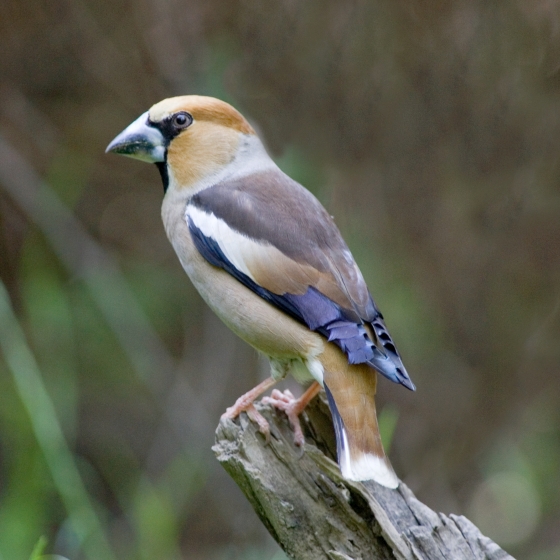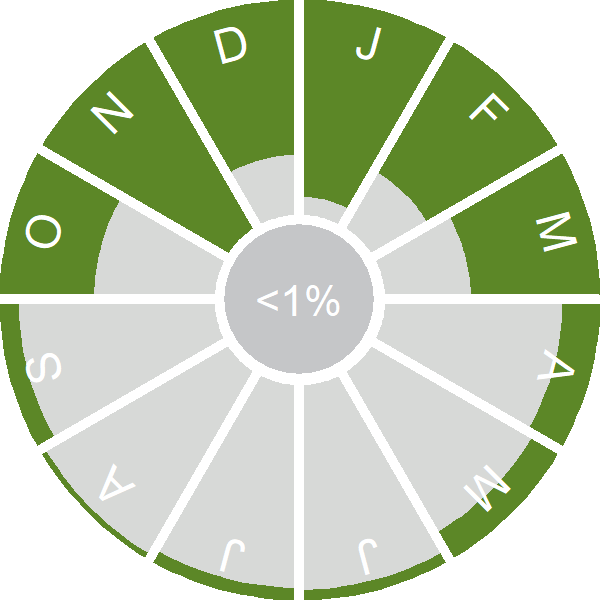Hawfinch

Introduction
A large orange-brown finch shaped like a rotund Starling, the Hawfinch possesses a massive beak for cracking hard-stoned fruit.
The Hawfinch has been Red-listed in the UK since 2009 because of recent breeding decline. Its breeding range is restricted to disparate sites, mostly in England and Wales. The species' winter range is bigger, with individuals found in northern Scotland and Ireland.
Generally nesting in mature woodland in the UK, the flocking instinct of the Hawfinch is often observed where they feed and during winter roosts (if you are lucky enough to see a Hawfinch then there is probably at least one other nearby). In winter, Hawfinch numbers are increased by influxes from northern Europe, which are bigger in some years than in others.

Key Stats
Identification
Songs and Calls
Call:
Status and Trends
Conservation Status
Population Change
This species is difficult to monitor due its scarcity and elusive behaviour, but analysis of county bird reports suggested the population increased in the 1970s and early 1980s but decreased in the 1990s (Langston et al. 2002). This decline has continued subsequently and the distribution of the species in the UK has declined substantially over the last fifty years (Balmer et al. 2013). The Hawfinch was consequently added to the Rare Breeding Birds Panel list in 2006, and the current breeding population of Hawfinch is likely to be around 1,000 pairs (Eaton et al. 2021).
Distribution
Hawfinches are a scarce breeder in Britain with a highly fragmented breeding distribution associated with larger tracts of mature broad-leaved and mixed woodland; it is more than three times more widespread in winter. In Ireland it does not breed and is only an irregular winter visitor.
Occupied 10-km squares in UK
2007/08–10/11
or view it on Bird Atlas Mapstore.
2008–11
or view it on Bird Atlas Mapstore.
European Distribution Map
Distribution Change
Between 1968–72 and 2008–11 the breeding range of the Hawfinch contracted by 76% in Britain, although the majority of losses occured since the 1988–91 Breeding Atlas. Losses are most concentrated in southeast England but extend into southeast Scotland. Although not monitored at a national scale, several sources point to a sustained population decline. In contrast, the British winter range has expanded by 28% expansion since the 1981–84 Winter Atlas, with gains most prevalent along the southwestern fringe of the range.
Change in occupied 10-km squares in the UK
from 1981–84 to 2007–11
or view it on Bird Atlas Mapstore.
from 1968–72 to 2008–11
or view it on Bird Atlas Mapstore.
Seasonality
Hawfinch is a localised winter visitor, passage migrant and rare breeder. Autumn passage peaks in late October.
Weekly pattern of occurrence
The graph shows when the species is present in the UK, with taller bars indicating a higher likelihood of encountering the species in appropriate regions and habitats.

Movement
Britain & Ireland movement
Foreign locations of birds ringed or recovered in Britain & Ireland
Dots show the foreign destinations of birds ringed in Britain & Ireland, and the origins of birds ringed overseas that were subsequently recaptured, resighted or found dead in Britain & Ireland. Dot colours indicate the time of year that the species was present at the location.
- Winter (Nov-Feb)
- Spring (Mar-Apr)
- Summer (May-Jul)
- Autumn (Aug-Oct)

European movements
EuroBirdPortal uses birdwatcher's records, such as those logged in BirdTrack to map the flows of birds as they arrive and depart Europe. See maps for this species here.
The Eurasian-African Migration Atlas shows movements of individual birds ringed or recovered in Europe. See maps for this species here.
Biology
Productivity and Nesting
Nesting timing
Egg measurements
Clutch Size
Survival and Longevity
Survival is shown as the proportion of birds surviving from one year to the next and is derived from bird ringing data. It can also be used to estimate how long birds typically live.
View number ringed each year in the Online Ringing Report.
Lifespan
Biometrics
Wing length and body weights are from live birds (source).
Wing length
Body weight
Ring Size
Classification, names and codes
Classification and Codes
- Order: Passeriformes
- Family: Fringillidae
- Scientific name: Coccothraustes coccothraustes
- Authority: Linnaeus, 1758
- BTO 2-letter code: HF
- BTO 5-letter code: HAWFI
- Euring code number: 17170
Alternate species names
- Catalan: durbec comú
- Czech: dlask tlustozobý
- Danish: Kernebider
- Dutch: Appelvink
- Estonian: suurnokk-vint e. suurnokk
- Finnish: nokkavarpunen
- French: Gros-bec casse-noyaux
- Gaelic: Glaisean-gobach
- German: Kernbeißer
- Hungarian: meggyvágó
- Icelandic: Kjarnbítur
- Irish: Glasán Gobmhór
- Italian: Frosone
- Latvian: dižknabis, svirpis
- Lithuanian: svilikas
- Norwegian: Kjernebiter
- Polish: grubodziób (zwyczajny)
- Portuguese: bico-grossudo
- Slovak: glezg obycajný
- Slovenian: dlesk
- Spanish: Picogordo común
- Swedish: stenknäck
- Welsh: Gylfinbraff
- English folkname(s): Grosbeak
Research
Causes of Change and Solutions
Causes of change
The causes of the decline in the UK are not yet known and the decline contrasts with mainland Europe where numbers have remained stable (PECBMS). Habitat loss, habitat degradation and predation have been suggested as possible causes of decline in the UK but have not been fully investigated (Langston et al. 2002). Based on the distribution from the most recent Bird Atlas (2008–11) Hawfinches are most likely to have persisted in areas with high woodland cover and where there has not been recent woodland management, although the presence of open areas within woodlands is important (Kirby et al. 2015). Although recent estimates from the Nest Record Scheme have suggested nest productivity may be low, nest success rate is unlikely to be the cause of decline as nest success rates during an intensive study across two areas in 2013–17 were similar to that from other studies of Hawfinch or similar species (Kirby et al. 2018); hence survival (of fledglings or adults) is more likely to be driving the UK decline.
Publications (1)
Birds of Conservation Concern Wales 4: the population status of birds in Wales
Author: Johnstone, I.G., Hughes, J., Balmer, D.E., Brenchley, A., Facey, R.J., Lindley, P.J., Noble, D.G. & Taylor, R.C.
Published: 2022
The latest review of the conservation status of birds in Wales. The report assessed all 220 bird species which regularly occur in Wales. There are now 60 species of bird on the Red List, with 91 on the Amber List and just 69 - less than a third of the total number of species - on the Green List. The latest review of the conservation status of birds in Wales comes 20 years after the first, when the Red List was less than half the length it is today. The report assessed all 220 bird species which regularly occur in Wales. There are now 60 species of bird on the Red List in Wales, with 91 on the Amber List and 69 on the Green List. The Birds of Conservation Concern in Wales report assesses the status of each species against a set of objective criteria. Data sources include the BTO/JNCC/RSPB Breeding Bird Survey and the BTO/RSPB/JNCC Wetland Bird Survey, as well as Bird Atlases and other BTO-led monitoring schemes and citizen science initiatives. These are used to quantify the changing status of the species’ Welsh population. The UK, European and global conservation status of the species is also considered, placing the Welsh population into a wider context. The Red ListSwift, Greenfinch and Rook – familiar breeding species in steep decline across the UK – are among the new additions to the Welsh Red List, which now also includes Purple Sandpiper, on account of a rapidly shrinking Welsh wintering population, and Leach’s Petrel, an enigmatic seabird in decline across its global range. These species now sit alongside well-known conservation priorities, such as Curlew, Hen Harrier and Turtle Dove as birds at risk of being lost from Wales for good. Uplands and woodlands Many of the species on the Red List are found in upland and farmland habitats. Starling, Tree Sparrow, Yellow Wagtail and Yellowhammer can no longer be found in much of Wales, while iconic species of mountain and moorland, such as Ring Ouzel, Merlin and Black Grouse, remain in serious trouble. Wales is well known for its populations of woodland birds; however, many of these – including Lesser Spotted Woodpecker, Willow Warbler and Spotted Flycatcher – also feature on the Red List. Goldcrest, which has seen its Welsh population shrink alarmingly in recent decades, is another new addition. On the coast The assessment for Birds of Conservation Concern Wales 4 took place before the impacts of avian influenza could be taken into account. Breeding seabird species have been struggling in Wales for many years, however, and most were already of conservation concern before the outbreak of this disease. Kittiwake, Puffin, Black-headed Gull, and Common, Arctic and Sandwich Tern remain on the Red List. Wales holds internationally significant numbers of breeding seabirds, making the decline of these colonies a global concern. The Amber ListDeclines in Wheatear, Garden Warbler and House Martin - all migrants which breed in Europe and winter in sub-Saharan Africa - mean these species have moved from the Green List to the Amber List. Many other ‘Afro-Palearctic' migrant species are also in decline, but the potential reasons for this, such as habitat loss and reduced availability of invertebrate prey, are not well understood. Closer to home, the declines in the Welsh Chaffinch population, linked to the disease trichomonosis, have seen the species Amber-listed. A number of other species have been placed on the Amber List because of the wider importance of their Welsh populations, which in each case make up more than half the UK total. Wales is home to more than three-quarters of the UK’s Choughs, for example, so recent declines are cause for concern. The nation’s breeding populations of Manx Shearwater, Pied Flycatcher, Goshawk and Hawfinch also account for more than half the UK total, as does its wintering population of Spotted Redshank. It’s not all bad news, though: some species now on the Amber List have moved up from the Red List, indicating some positive change in their population trends. These include Common Sandpiper, Great Black-backed Gull, Bullfinch, Goldcrest and Pied Flycatcher. The Green ListWhile the report contains much cause for alarm, several conservation success stories shine through. Red Kite was almost lost as a British bird during the first half of the 20th century, when only a handful of pairs remained in remote Welsh valleys. Since then, a sustained conservation effort has brought the species back from the brink. Wales is now home to more than 2,500 pairs of Red Kite and the species has now been moved to the Green List, reflecting this incredible change in fortunes. Song Thrush, Reed Bunting, Long-tailed Tit, Redwing and Kingfisher are among the other species to have gone Green, providing much-needed hope that things can go up as well as down.
06.12.22
Reports Birds of Conservation Concern

More Evidence
More evidence from Conservation Evidence.com
Partners
Citing BirdFacts
If you wish to cite particular content in this page (e.g. a specific value) it is best to use the original sources as linked in the page. For a more general citation of the whole page please use: BTO (20XX) BirdFacts Species: profiles of birds occurring in the United Kingdom. BTO, Thetford (www.bto.org/birdfacts, accessed on xx/xx/xxxx).

